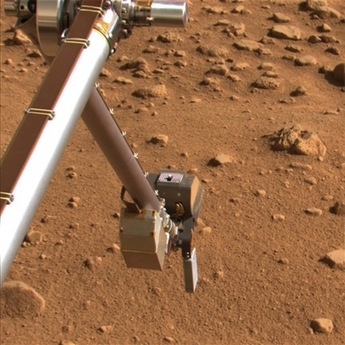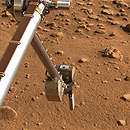Mars is alive! Methane discovered
TG Daily
January 15, 2009
Washington (DC) - NASA announced today that for the first time ever they have definitively detected methane in the Martian atmosphere. The discovery indicates "the planet is either biologically or geologically active," according to NASA.
NASA used it's Infrared Telescope Facility in Mauna Kea, Hawaii, along with the W.M. Keck telescope - also located in Hawaii. By observing Mars closely over several years, the telescope's spectrometers revealed three spectral features called "absorption lines" which, when present together, indicate methane.
According to NASA's Goddard Space Flight Center in Greenbeldt, MD, Michael Mumma, "Methane is quickly destroyed in the Martian atmosphere in a variety of ways, so our discovery of substantial plumes of methane in the northern hemisphere of Mars in 2003 indicates some ongoing process is releasing the gas. At northern mid-summer, methane is released at a rate comparable to that of the massive hydrocarbon seep at Coal Oil Point in Santa Barbara, California."
Methane, which is comprised of four hydrogen atoms bound to a single carbon atom, is the main component of natural gas on Earth. Astrobiologists are interested in this new data because organisms release much of Earth's methane as they consume nutrients. However, other purely geological processes (like the oxidation of iron) also release methane.
Mumma said, "Right now, we do not have enough information to tell whether biology or geology - or both - is producing the methane on Mars. But it does tell us the planet is still alive, at least in a geologic sense. It is as if Mars is challenging us, saying, 'Hey, find out what this means.'"
NASA indicates that if the methane gas is the result of microscopic Martian life, it likely resides well below the surface. On Earth, similar microorganisms thrive between 1.2 and 1.9 miles beneath the Witwatersrand basin of South Africa, for example. There, a natural radioactivity splits water molecules into hydrogen and oxygen. The deep Earth-based organisms use the hydrogen for energy, according to NASA. And according to Mumma, it may be similar on Mars - that they reside beneath the permafrost in much the same way.
Geronimo Villanueva of the Catholic University of America in Washington, who co-authored the paper on the finding, said, "We observed and mapped multiple plumes of methane on Mars, one of which released about 19,000 metric tons of methane. The plumes were emitted during the warmer seasons, spring and summer, perhaps because ice blocking cracks and fissures vaporized, allowing methane to seep into the Martian air."
According to the team, the plumes were seen over areas that show evidence of ancient ground ice or flowing water. Plumes appeared over the Martian northern hemisphere regions such as east of Arabia Terra, the Nili Fossae region, and the south-east quadrant of Syrtis Major, an ancient volcano about 745 miles across.
Research for this finding was paid for by the Planetary Astronomy Program at NASA Headquarters in Washington and the Astrobiology Institute at NASA's Ames Research Center in Moffett Field, Calif. The University of Hawaii manages NASA's Infrared Telescope Facility.





 Share your thoughts in the Forum
Share your thoughts in the Forum
